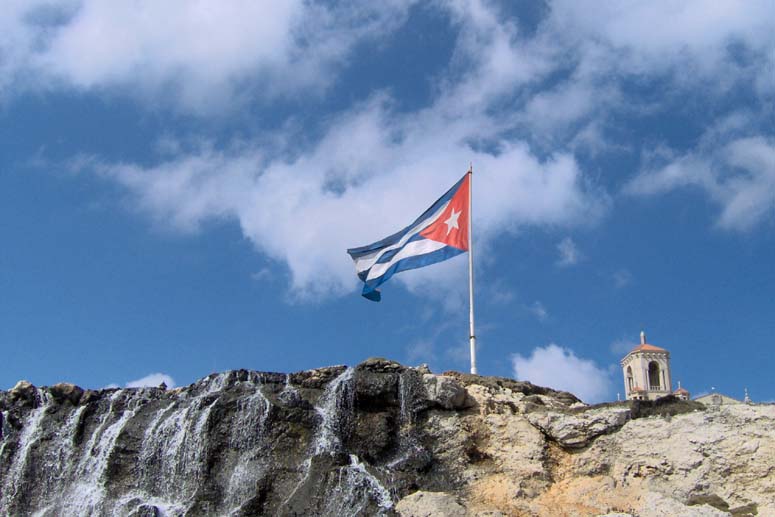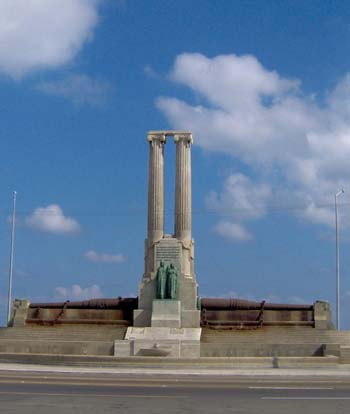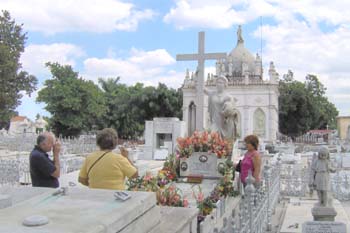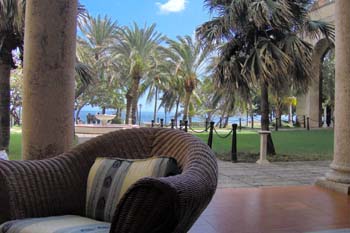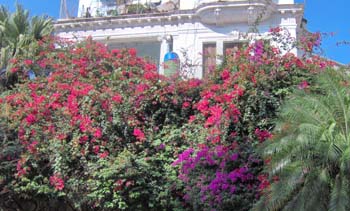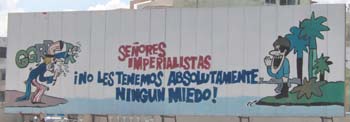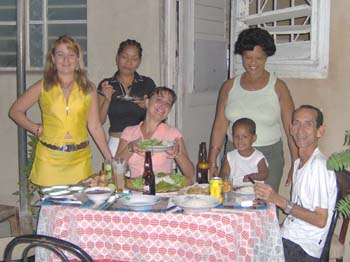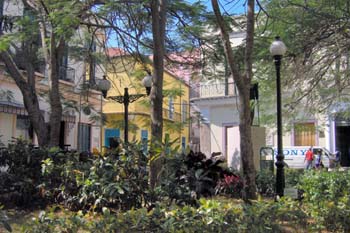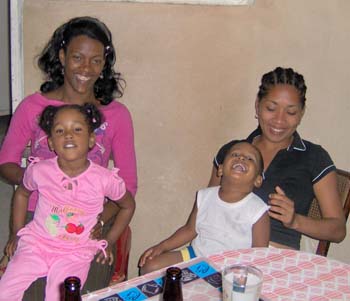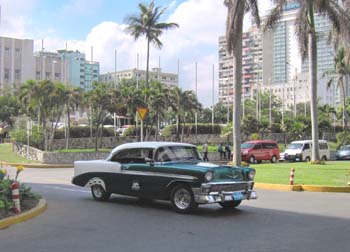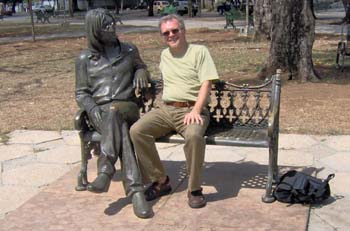On the walls of the bunkers there are interesting
displays of sensationalistic newspaper headlines, photos, and other
memorabilia of that time including a note from the producers of
Thirteen
Days, the recent Hollywood film (starring Kevin
Costner) about the crisis, acknowledging Castro’s assistance
in its making. A visit to the bunkers of the Hotel Nacional gives
one a powerful, first-hand impression of a tumultuous event of recent
North American history, one that almost led to a nuclear holocaust.
Walk of Fame
On a much lighter note, Estela’s excellent
tour of the hotel also included a visit to its renowned “Hall
of Fame,” where photos of some of the famous people who have
stayed there since the 1930s are prominently displayed. Among them
are film stars, writers, artists, heads of state, and more than
a few dubious characters from Havana’s shady criminal past.
One of the most enjoyable ways to pass time at the hotel is to sip
an excellent mojito
on the hotel’s beautiful inner courtyard, looking out on the
impressive seaside view as peacocks stroll across the well-manicured
lawn. It is pleasant to think that people as different as Ava Gardner,
Frank Sinatra, Meyer Lansky, Winston Churchill, Josephine Baker,
and John Wayne — to say nothing of more recent guests like
Naomi Campbell, Jack Nicholson, and Oliver Stone — have all
probably done the same during their stays. Inside the hotel one
can view the spacious, ornately decorated meeting room that the
notorious gangster Meyer Lansky had set aside for secret meetings
of his criminal syndicate in the days prior to the revolution.
Upstairs, on the second floor, Estela eagerly
ushered us into the Nat “King” Cole suite, where the
renowned jazz singer frequently stayed during his many appearances
at the Hotel’s famous nightclub, the Cabaret
Parisien. It has been kept exactly as it was, and its
1950s-era period décor is particularly charming. Estela pointed
out that before the “triumph” of the revolution in 1959,
the hotel was strictly segregated on racial grounds, and even the
pre-revolutionary Cuban dictator Fulgencio Batista had been denied
entry because of his mixed racial background. For this reason, Nat
“King” Cole had been granted special permission not
only to perform there, but also to stay in one of its rooms. As
a special fan of Nat’s vocal style, Estela was undeniably
proud that the great crooner had once been a regular guest at the
hotel whose history she so proudly recounts to those who take her
tours.
Who's On First?
The Hotel Nacional contains many upscale
restaurants, cafés, and shops, but in my opinion one of its
most unusual, and perhaps even unexpected venues is the small Café
el Rincon del Cine, located on the lower level adjacent to the main
dining hall. This café is probably the closest thing one
could find in Havana to an American-style burger joint, and the
hamburgers, french fries, and hotdogs on offer there are all first
rate. The day I visited, the wait staff and customers were all transfixed
by what was taking place on television, namely the semi-final game
of the World Baseball Championship, being played in San Diego, California.
Cuba was facing the Dominican Republic, a team composed of some
of the best players in the American and National Leagues, and passions
were running high throughout Havana and the island at large.
Shortly before game time, I had looked out
my hotel window and saw practically no one on the streets. Ever
since my arrival in Cuba, I had noticed how important this series
was to the people’s sense of national pride and love of the
game. A few days before, while strolling along the tree-lined streets
of Vedado, the formerly upscale neighbourhood near the hotel, I
had come across group of men of all ages engaged in a fierce and
animated discussion. Thinking at first it was a political rally,
I approached gingerly, only to discover that I had come across one
of Havana’s two esquinas calientes, or hot corners,
where passionate baseball fans meet regularly to argue about their
beloved game. Everywhere I had noticed houses bedecked with flags
and posters sporting the confident claim Cuba campione!
(Cuba champion!), expressing people’s fervent hope that the
island would emerge triumphant in the all-important series.
Service was understandably slow as I waited
for my lunch, while watching the game’s drama unfold on the
large-screen television set up in the café. Everyone was
enthralled with the action, as a young Cuban pitcher named Marti
(the same last name as Cuba’s greatest national hero of the
War of Independence, José
Martí) faced down the likes of “Papi”
Ortiz and other major league heavy hitters, striking many of them
out. After a few tense moments, Cuba eventually won the game, and
as soon as the last inning was over, the Hotel Nacional and the
entire city surrounding it erupted in euphoria. A Cuban flag was
unfurled in the lobby, with ecstatic staff and guests alike posing
for pictures. Outside, crowds flocked to the Malecon, waving flags,
singing, crying, and shouting. (As a Toronto native, it reminded
me of similar scenes of jubilation in my home city when the local
baseball team, the Blue Jays, won the World Series in 1992 and 1993.)
I took a taxi through the chaotic streets to a private dinner engagement
with some Cuban friends in Cerro, a decidedly run-down, untouristy
quarter of Havana where the national passion for baseball probably
runs higher than in any other place on the island.
Cerro’s people are known for two things:
their love of rum and baseball. One of Cuba’s best distilleries,
which turns out the renowned Ron Legendario, a delicious dark rum,
is located in the area, as is Havana’s main baseball stadium,
the Estadio Latinoamericano. It is home field to Los
Industriales, the New York Yankees of Cuba’s
National League, the team that has won far more championships than
any other on the island. That evening, all of Cerro’s inhabitants
seemed to be in the streets, rapturously celebrating the national
team’s victory over its Dominican rivals. It was indeed a
memorable experience for me to share this moment of triumph with
ordinary Cubans, for whom life is frequently a difficult struggle.
While Cuba eventually lost the final game of the series a few days
later against a disciplined but decidedly colourless Japanese team,
the national passion for baseball remains at a fever pitch. I wondered
whether one day it might be possible to see the Cuban national team
in action against an AL or NL franchise, or perhaps even the very
best players that the United States could field against them. It
had happened once before, when the Baltimore Orioles played some
exhibition games in Havana during the 1990s. But with the chilly
relations between the two countries now prevailing, such an intriguing
prospect seemed sadly unlikely, at least for the immediate future.
Church and State
After experiencing the championship series
in Havana, one could be forgiven for thinking that baseball was
Cuba’s national religion! But despite decades of communist
rule, the island’s people remain devoutly religious, and their
spiritual expressions take on many distinct and unique forms. Cuba
is a predominantly Roman Catholic country, where church and state
have coexisted in a frequently uneasy relationship since the triumph
of Castro’s revolution. For many years, however, Catholicism
was barely tolerated, and believers found it difficult if not impossible
to advance very far in state or communist party ranks, and occasionally
faced political persecution. However, with the visit of the late
pope John Paul II to the island in 1998, things began to change
dramatically. Many of Havana’s priceless colonial-era churches,
convents, and other religious buildings are being lovingly restored
and turned into museums. Fidel himself has indicated his support
for progressive tendencies within the Catholic Church, such as the
gospel of “liberation theology” that stresses the church’s
duty to support the poor and speak out against social and political
injustices. He was especially gratified when the Pope denounced
the long-running U.S. economic blockade against Cuba, and called
for the normalization of relations between the two countries.
Today, many younger Cubans are actually returning
to the faith of their forebears, while some are even embracing the
new evangelical Protestant denominations, many of them offshoots
of parent churches in the United States. It is not unusual to see
young Cubans wearing crosses and other religious symbols, and Havana’s
main cathedral in the old part of the city is starting to attract
larger crowds of worshippers at Sunday mass, both locals and tourists
alike. One of Cuba’s most fascinating religious beliefs, however,
is santeria,
the island’s version of Voodoo, which black slaves from Africa
brought to the island during the period of the great “sugar
boom” in Cuba’s colonial economy that began in the 18th
century. Santeria is also known as the regla de ocha, and
is believed to derive from the animistic religious cults practiced
by the Yoruba people of West Africa. It centres on the worship of
orishas, or nature deities that represent different natural phenomena
in human form. For instance Chango is the god of thunder, Yemaya
the goddess of the sea and motherhood, Ochun the goddess of love
and fresh water, and Elegua the god of the crossroads, destiny,
and prosperity. Far more than a bundle of superstitions and magical
practices, santeria is a complex, complete religious system,
with its own gods, beliefs, priests, and ceremonies. It retains
a strong hold over the minds of many Cubans to this day, and when
Castro was hospitalized in the summer of 2006, the government invited
santeria priests, called babalawos, to pray for
the leader’s speedy recovery.
To fully appreciate the importance of this
religious cult in contemporary Cuba, the best place to visit is
the Museo de los Orishas (museum of the orishas) located in central
Havana just across from the Parque Central. Unlike almost every
other museum in the city, this is a privately-run institution that
receives no official support from any government body, and depends
solely on visitors’ donations for its maintenance. Upon entering
the main exhibition room, I was met by a young man who told me in
excellent English that he was training to be a babalawo.
He explained to me the importance of each person’s discovering
his own personal orisha, or spiritual guide who would assist
him or her in dealing with life’s joys and challenges, and
finding the correct path to follow. When I asked him how I could
know mine, he told me to just gravitate towards the first statue
that caught my interest. The room contains a great number of larger-than-live
terra cotta statues of the various orisha deities, many
of which were surrounded by offerings from their followers, including
flowers, fruits, herbs, and even money.
Almost instinctively and without knowing
exactly why, I soon found myself standing in front of Elegua, the
“master of the crossroads.” Elegua is an orisha
who helps those who follow him to find new paths in life and deal
with the inevitable changes one faces as time passes. This is especially
important for those who have experienced difficult, painful personal
transitions and transformations. The more I learned about this orisha,
one of the most powerful and benificent in the Yoruba pantheon,
the more he appealed to me, and the more pleased I was with my choice.
But when I told the babalawo-in-training about my decision,
he asked me a question that still rings in my ears: Was it I who
had chosen Elegua or Elegua who had chosen me? Later I was intrigued
to discover that Elegua had been the personal orisha of Toussaint
L’Ouverture, the great leader of the epic slave
revolt that broke out in Haiti at the close of the 18th century,
a historical figure whom I had long admired!
The religion and spirituality of the Cuban
people can also be appreciated in Havana’s vast, sprawling
central cemetery, the Cementerio y Necropolis Colon, located
in Vedado, not far from the monumental Plaza de la Revolucion.
It is a fantastically ornate, baroque burial place, literally a
“city of the dead,” that houses the remains of many
outstanding figures in Cuban history. Originally developed in the
late 19th century as the resting-place for Havana’s élite
families, the impressive family plots lining the various streets
of the cemetery are laid out in a strict social-class hierarchy
and are all above ground level. One of the most impressive monuments
is the exquisitely carved Monumento a los Bomberos, dedicated
to the 28 Havana firefighters who died while battling a blaze at
a downtown hardware store in 1890.
Cubans Remember
But even more moving is the sprawling memorial
to the young Cuban servicemen and women of the FAR (Fuerzas
armadas revolucionarias), who sacrificed their lives in the
various wars the country has fought since the beginning of the revolution,
both on Cuban soil and on foreign fields of battle. The day I visited,
it was affecting to notice a middle-aged woman escorting a young
girl, neatly dressed in her school uniform and carrying a bouquet
of flowers, to the wall where the names of all the fallen are recorded.
The woman carefully explained something to the girl as they paused
there, and I found myself wondering who it was they were remembering
that day. Was it a father, grandfather, or other family member who
had died in Africa during the 1970s or 80s when Cuban forces played
a key role in bringing about the fall of apartheid in South Africa?
In the end, I decided it would not be appropriate for me to intrude
on their private moment of mourning and commemoration. Nonetheless,
it was a powerful reminder of the high price Cuba’s people
have been asked to pay for the prominent global course their leaders
have charted for them over the past few decades. A short distance
away, I found the grave of
Alejo Carpentier, the renowned Cuban novelist and diplomat
who died in 1980. On his simple, elegant tombstone is inscribed
the following, fitting epitaph: “ I am a man of my time, and
the transcendental event of my time is the Cuban revolution.”
My last stop at the cemetery was at what
is probably its most-visited site, the mysterious grave of a woman
named Amelia Goryi de Hoz, who died in childbirth in 1901 and was
buried with her stillborn baby at her feet. Years later, when her
tomb was opened, the dead child was found lovingly cradled in its
mother’s arms! After this remarkable discovery, Amelia became
known as la milagrosa (the miraculous one), and her resting-place
has become the site of a popular cult. The day I visited, a small
group of women was laying flowers on the grave and conducting a
religious ceremony, probably asking favours from the miraculous
young woman buried beneath them. Because the cemetery is so vast,
it is a good idea to obtain a map at the information booth to the
right of the main entrance, where it is also possible to hire an
excellent, English-speaking guide for a formal tour. But whenever
I pay a visit to massive, historic cemeteries like the Colon, or
London’s Highgate, Paris’s Père Lachaise, or
New Orleans’ St. Louis for that matter, I prefer to explore
them on my own. On these special occasions for personal reflection
and meditation, I like to surround myself in private thoughts and
speculations. I ask myself what these silent, solemn sites and those
buried there might tell me about the history of the cities and countries
that I am visiting at the time.
John and Vladimir
Havana is no doubt the only city in the world
that has a park named after “Lenin” and another one
named after “Lennon.” Lenin Park, on the outskirts of
Havana, is a vast, but now sadly neglected and run-down monument
to the days when Cuba was the former Soviet Union’s loyal
Caribbean ally. A giant statue of Vladimir Lenin dominates this
huge area of greenery and poorly maintained amusement parks and
other recreational facilities. Because of the problems in maintaining
the city’s creaking, dilapidated public-transit system through
the years of economic crisis following the fall of communism, it
is now very difficult for ordinary Havana families to visit Lenin
Park, and I did not include it in my tour. But on a quiet, leafy
Vedado street not far from the hotel, I did encounter the statue
of the other famous “Lennon” — that being John
of the Beatles, who can be found posing nonchalantly on a park bench,
wearing his trademark wire-frame glasses.
Fidel Castro himself opened Lennon Park personally
in December 2000, on the 20th anniversary of Lennon’s shooting
in New York. On that occasion, he declared that “there are
vindications that are just.” In making this gesture of commemoration
to a great artist, he was actually acknowledging one of his Revolution’s
many mistakes, that being the crackdown on rock music that the régime
conducted during the 1960s. For years it was almost impossible for
young Cubans to obtain recordings of the Beatles and other popular
groups, but all this has changed completely today. The UNEAC, the
Cuban National Union of Writers and Artists, has convened numerous
seminars and conferences on the importance of rock music at its
beautiful nearby headquarters. In addition, the younger generation
of Cuban artists is turning to American-inspired rap and hip-hop
as an avant-garde form of musical expression and social commentary.
It is possible to sit posed beside the statue
of Lennon on the park bench, and have the guard on duty take your
photo, as I did that day. I later learned that the guard’s
main role is to prevent anyone from stealing the eyeglasses, which
apparently was a serious problem shortly after the park was opened.
At the foot of the statue the following message is inscribed, from
John Lennon’s famous song “Imagine”: “You
may say that I’m a dreamer, but I’m not the only one.”
While reading it, I found myself wondering whether another aging
dreamer, who continues to pursue a revolutionary path for his country
against all odds, finds any personal meaning in these words. To
me, they seem even more timely than ever as he approaches what undoubtedly
will be the final stage of his remarkable political career on the
world stage, and leaves behind a mixed legacy for the people he
has led for so many decades.
À la Carte Cubaine
While no one would claim that Havana is a
world-class culinary destination, the city does offer some intriguing
opportunities to savour the best of Cuban cuisine. One of my favourite
stops in the city is the Coppelia, the huge ice-cream parlour designed
to resemble a flying saucer, that takes up an entire city block
in the centre of Vedado, a short walk from the Hotel Nacional. There
it is possible to sit at a table or park bench and to share a delicious
ice cream with ordinary Cubans and tourists alike. In fact, the
famous 1993 film Strawberry
and Chocolate, whose main figures were two young
Cuban men — one gay and the other straight — began at
the Coppelia. This film probably did more than anything else to
bring an end to another of Castro’s mistaken policies, the
harsh and punitive measures the régime imposed on gay and
lesbian Cubans and HIV/AIDS sufferers, which are now happily a thing
of the past. The film’s title says it all, for while the Coppelia
may not be Baskin and Robbins, with a very small number of flavours
on offer, it makes up in quality for what it lacks in quantity.
Cuban ice cream is world-famous, and the day I was there I enjoyed
a dish of with two delicious scoops — not strawberry and chocolate
this time, but mango and coconut, topped with whipped cream and
chocolate sauce!
One short block away from the Coppelia is
a small, family-run restaurant known appropriately as Las tres
Bs (The three Bs); the B’s standing for bueno, bonito
and barato, (good, pretty and cheap). This is just one of the
many paladares, or small eating-houses that have sprung
up all over Havana in the most unexpected locations, as the régime
continues to make its reluctant but inevitable concessions to small-scale
private enterprise. Without a guide it is almost impossible to find
places like Las Tres Bs, since strict government advertising
restrictions prevent them from posting large signs indicating their
locations to passersby. But neighbourhood locals are more than happy
to point out the stairway to the small, unpretentious apartment.
Here the friendly members of the Alfonso family are happy to provide
the hungry visitor with heaping plates of fried chicken, beans and
rice, fresh salads, and a delicate flan pudding for dessert. They
also have cold Cristal or Buccanero beer on hand to accompany the
meal.
Havana’s paladares run the
gamut from small, homey places like Las Tres Bs to somewhat
more upscale dining houses. Two of these I had the opportunity to
visit during my last visit were Las Mercedes and Aries, both of
which are also located in Vedado. Las Mercedes has a very romantic
atmosphere, since one enters its main, private, subtly-lit dining
room through a lush tropical mini-garden, complete with a fishpond
and a wooden bridge. Here the fare on offer is more imaginative
than the usual chicken, pork, beans, and rice staples found at less
fancy establishments, and it is possible to dine on seafood kebabs
or deliciously grilled swordfish, and imaginatively-served vegetables.
Aries, another small paladar near the University of Havana,
is also a good bet for a well-prepared meal that can be enjoyed
in the exquisite 19th-century surroundings of a former Vedado mansion.
The night I visited, I tried a famous Cuban dish with the unusual
name of ropa vieja (old clothes). This certainly tastes
much better than it sounds, for it is a stew of shredded beef, subtly
flavoured with local herbs and spices, served over rice. An after-dinner
digestif and coffee can also be savoured here, as one enjoys the
comfort of what one must have been a very prestigious home.
On the Town
Cubans tend to dine late, but after dinner
the city’s exciting and varied nigh life is only just beginning
to get under way. Cuba’s musical scene is second to none in
the world, and there are many venues where all the different styles
of music — salsa, jazz, rumba, boleros, or
son can be enjoyed. And whenever Cubans play
music, one can almost certainly expect that dancing will quickly
ensue. On my last visit, I was taken to La Maison, an upscale club
in the fashionable Havana suburb of Miramar, which is probably the
best glimpse a visitor may have of the new Cuba that is emerging
in the early 21st century. La Maison sports an exclusive restaurant,
some fancy shops, and an upstairs bar where an energetic group of
young musicians and singers was performing a medley of Latin-pop
hits. The second act of the show involved audience participation,
as a number of people tried their skills at karaoke to some famous
tunes. Finally, a comedian took the stage and delivered a rapid-fire
monologue touching on just about every aspect of contemporary life
in Cuba, much of which was unintelligible to me despite my moderate
command of Spanish. His jokes certainly touched a chord with the
receptive local audience, however, who laughed riotously after every
one.
On another evening I accompanied a group
of Cubans and a visitor from Spain to another one of Havana’s
famous comedy venues, the TV Café, just around the corner
from my hotel. This is a cavernous room where an extremely popular
and apparently quite famous young comedian was working the audience
like a Las Vegas stand-up veteran. Again, much of his humour was
lost on me, but I took some comfort in the fact that my Spanish
companion admitted that he only understood about half of it, since
most of the comedian’s schtick was delivered in broad Havana
slang. I asked my Cuban friends later whether there were any restrictions
on the subjects that comedians could deal with in their performances.
The reply was that just about any aspect of life on the island today,
including the many frustrations and difficulties they face, was
fair game. The only topic that was strictly off-limits, and taboo,
was anything directly reflecting on the lider maximo —
Fidel himself. But I did notice that the comedians even found their
way around this particular prohibition by making a hand gesture
that mimicked the stroking of an imaginary beard on their face,
whenever they wanted to make a veiled reference to the commandante!
As one of the few non-Cubans in the audience, I quickly became the
target of the comedian’s good-natured jibes, as he welcomed
me to the stage with a boisterous “Oh my God!” when
he found out I was from Canada. After his act was over, he gladly
posed for a photo opportunity with me.
If one wants a sense of how the younger generation
of Cubans enjoys an evening out, there are two attractive outdoor
nightspots that offer music, dining, dancing and some beautiful
views of the city. The Salon el Chevere is an open-air disco set
amidst the vine-draped rocks facing the Rio Almendares, in the Bosque
de la Habana district near Vedado. This complex offers two different
spots for dancing, and a huge swimming pool. The night I went there,
the predominantly young and extremely well turned out audience was
dancing enthusiastically to a Latin beat. I asked who these people
were, and how they were able to afford an evening out in such a
place when one takes into account the low level of average Cuban
salaries. The answer I was given was that these were the younger
members of an emerging privileged class, whose parents were most
likely (by Cuban standards) highly paid government or business officials.
I wondered what effect such newly emerging social and economic distinctions
were having on the core beliefs of Fidel’s socialist revolution
and its commitment to equality of all its citizens. Will the new
Cuba be able to reconcile the understandable demands of its younger
people for greater personal freedom and material possessions with
the revolution’s fundamental promise of social justice and
an equitable sharing of the country’s resources?
Whither Cuba?
My very last evening in Cuba found me in
a magical place, where I was able to reflect on my visit and all
that I had experienced and wondered about in such a brief time on
this evolving, fascinating island. It was the night Cuba had won
the semi-final baseball game, and I travelled by taxi across the
tunnel linking the old city to its newer eastern suburbs. My destination
was the Morro Castle, the gleaming white colonial era fort that
I had admired so many times from the window of my hotel room. That
evening, as the lights of old Havana glistened from across the bay,
I enjoyed some tranquil moments as a few couples around me swayed
to the music of a small band. Downstairs, at the historic restaurant
known as Los XII Apostoles (The Twelve Apostles), others dined on
the succulent dishes of roast chicken or beef for which it is famous.
As I looked around, impressed with the vitality
and joie de vivre of the young Cubans enjoying themselves on such
an unforgettable night, I silently hoped for the best, both for
them and for all of this remarkable island’s people. Much
is changing, and indeed much needs to change, as Cuba enters a new
era in its history, with perhaps a greater degree of personal freedom
and more openness to the rest of the world. But I also hope that
whatever changes may come, Cubans will be able to preserve the best
of their island’s unique culture, history, traditions, and
the undeniable accomplishments of their revolution, including a
system of public health care and education that is the second to
none in Latin America.
And even more, I wished that Cuba’s
extremely friendly and outgoing people would be able to continue
enjoying the various national passions — religion, baseball,
food and drink, music, humour, and history — that I had been
so grateful to share with them during my trip.
